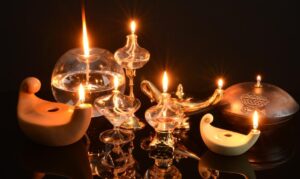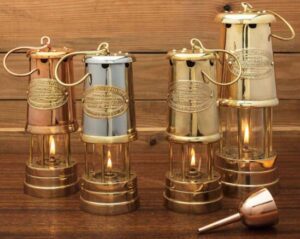In the olden days, people used oil lamps as a light source. They figured out how turn various materials into fuel sources to light the lamps. Oil lamps helped people to see for thousands of years until electric lighting was made available.
Today oil lamps are used primarily as a back up form of lighting or for novelty reasons. Keep reading to find out how do oil lamps work and how they can still provide light for people today.
Types of Oil Lamps and How Do They Work?
Oil lamps simply evolved from man’s need to have light at night. No one person invented the oil lamp. However, some ancient civilizations used them before others.
Some archaeologists claim that the lamps were first used well over 7,000 years ago by ancient cultures.
Ancient peoples that resided in the Mediterranean and the Middle Eastern regions of the world were among the first people recorded to use these devices.
Since oil lamps were advanced tech devices for their day, their use spread out to other parts of the world. Lamps that contained oil were used by the Chinese, Romans, Greeks, Israelites, Arabs, Germans, and the Indians. Each of these different civilizations had their own versions of oil lamps.
All oil lamps basically operate on the same principles. These principles are listed below:
1. Most oil lamps are containers that have some type of liquid inside of them. These devices could also be battery operated or even be powered through solar technology. Modern oil lamps can be charged up with electricity to generate light.
2. Ancient oil lamps were made out of many different materials such as stone, wood, earth (clay or hardened dirt) or metal. Modern oil lamps are made out of some type of heat-resistant plastic or metal.
3. Many oil lamps have wicks. However, some just have fuel but no wick. Oil lamps have different designs, and they will vary by manufacturer. Ancient oil lamps created by different cultures in the past also had a different design and function.
4. The wicks in oil lamps are lit by a fire and they are used to light the fuel inside of the unit. Once the wick is lit and the fuel is lit, the lamp will put out light. Oil lamps that do not have a wick use the same principle except the fuel is simply burned without a wick.
Electric or battery-operated oil lamps can be lit by sending an electric spark to light up the fluid. This type of oil lamp is not very common but they are available for use. They keep people from having to light a wick with fire.
5. Once the lamp produces a flame for light, this flame is usually adjustable with knobs. However, some oil lamps do not allow users to adjust the flame.
What Are the Types of Fuels for Oil Lamps?
There are many different types of fuels that can be used for oil lamps.
- However, kerosene is the most common type in use today.
- In the past, people used animal fats for lighting oil lamps. Whaling a huge industry during the 18th and 19th centuries. This changed when electric lighting was invented.
- Food-based fuels are also used. Fossil based substances are the most popular.
- Various fuel sources such as gas, ethanol, and diesel can also be used inside of oil lamps.
Olive oil, various food-based oils and even animal fat can also be used as substances to power oil lamps.
If you are on the market for smokeless paraffin oil to use on the indoor/outdoor oil lamps, Firefly 1-gallon is the best choice.
Are Oil Lamps Bad for Your Health?
Oil lamps are not generally bad for a person’s health. However, they can be health hazards depending on the factors listed below if you can’t use them properly.
Things You Should Avoid When Using Oil Lamps
1. Not Allowed for Children
Oil lamps are not recommended for small children or for people who do know how to properly use them. Oil lamps are fire hazards. In the past, young people knew how to operate these devices without burning themselves or their houses up.
Many kids today simply turn on a light switch or use a flash-light to see in the dark. Today, there will be some kids who could learn how to use an oil lamp.
Still, many kids would probably harm themselves today, if you had to go back to consistently using these devices. This is also true for adults who are not familiar with these devices.
2. Not Allowed for Enclosed Space
People would improperly use the flammable material for the lamps, or they might set the lamp on a flammable object. They will also leave the oil lamps burning without supervision. Oil lamps pose a big fire hazard for people who are not know how to manage these devices.
Most oil lamps should be used in a well ventilate area.
Don’t use these devices in enclosed spaces with babies, young children, and people with severe breathing problems. The waste materials that are produced by oil lamps can negatively impact their breathing.
Can Oil Lamp Explode?
No. Most oil lamps will not explode. They are not designed for this purpose. Also, if they were that volatile, they would not be sold as commercial products.
Kerosene is the most common type of fuel used in oil lamps today. This substance will explode if it reaches a flashpoint. The flashpoint level for kerosene is between 37 and 65 °C or 100 and 150 °F. These numbers simply tell us that if a heating source is at least 100 degrees F (37 C) then there is potential for the kerosene to explode.
If a person decides to use a heating torch to light up their kerosene lamp it could explode. While this doesn’t happen often, it does take place.
No one should be lighting their oil lamps inside of an environment or area where gas is floating around. This type of situation could also cause an oil lamp to explode. People should pay attention to their surrounding environment to avoid this issue.
People should make sure that there is plenty of oxygen and air flow when they light an oil lamp. There also should not be any gases around that they can detect before lighting the lamp.
How to Light/Use an Oil Lamp?
Here are some basic instructions about how to light/use an oil lamp:
1. Examine the lamp unit for any problems or defects. You want to avoid any fuel from spilling out the unit and you want to make sure it works properly.
2. Fill the oil lamp unit up with kerosene or some other type of fluid. Make sure you don’t overfill the unit.
3. Check your wick to ensure that it is properly adjusted. You want enough length on the wick to lit it without your flame touching the fuel.
However, if you have an electric model, make sure the spark or charge on the unit is properly working. Follow your unit’s instruction manual to make this determination.
4. Light the unit and put it in a place that is free from fire hazards. This is important for preventing fires and keeping yourself from being burned.
5. You can also use a knob adjusted to increase the flame or to decrease it. Increasing the flam provides you with more light and uses more fuel. Decreasing the flame gives you less light and uses less fuel.
6. Make sure you use your oil lamp in a well-ventilated place that is out of the reach of young children. You should also keep these units away from pets.
7. Never leave your oil lamp unattended. This could create a fire hazard or cause someone to get burned.
8. Never operate an oil lamp while you are intoxicated, using medications, or when you are not in your right mind. This could quickly lead to fire or burn injury.
9. Make sure you are not lighting your lamp in an area where you detect gas vapors.
10. Never light an oil lamp in an area where there is a lot of instability and/or chaotic behavior. A person could inadvertently (or purposely) knock the lamp over and/or use it as a weapon. This in turn could create a huge fire or cause someone to be injured.
Conclusion
Oil lamps are still one of the preferred light sources in modern times. People generally use them only as emergency forms of lighting and as a novelty.
Everyone using an oil lamp should know how to properly operate the device to avoid any potential problems or issues.


